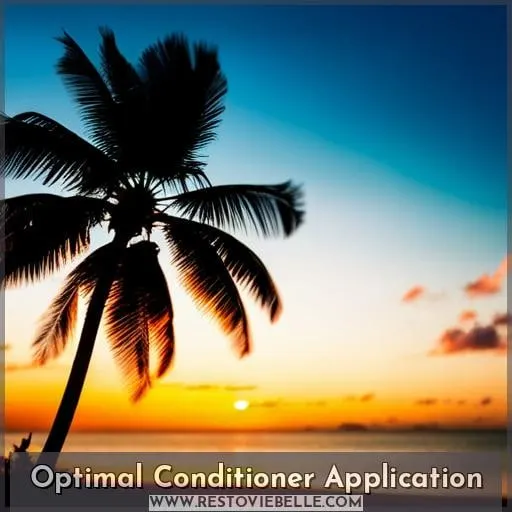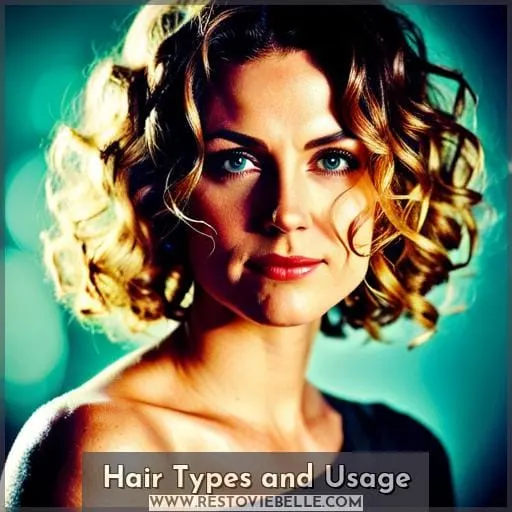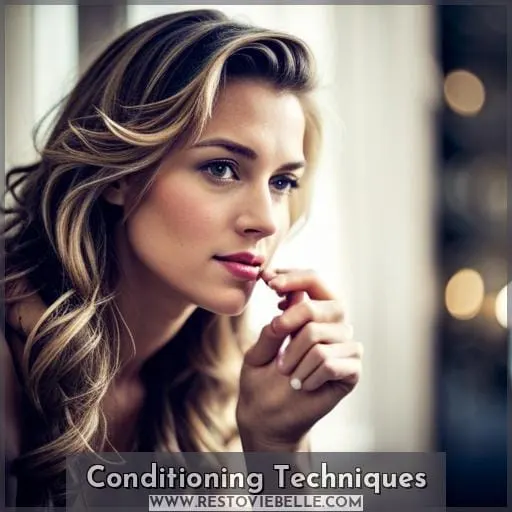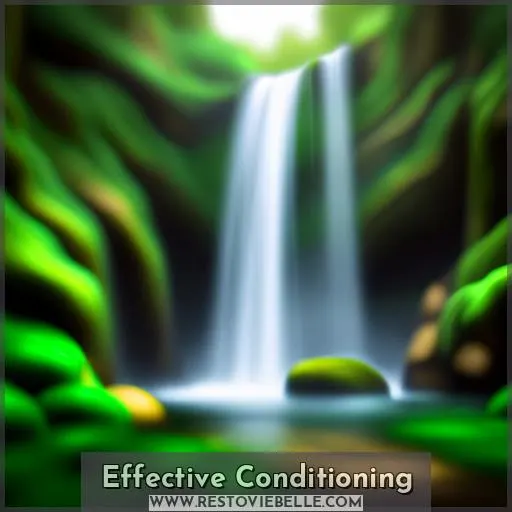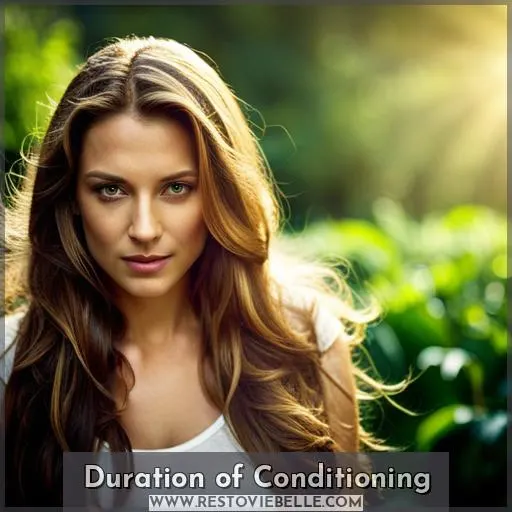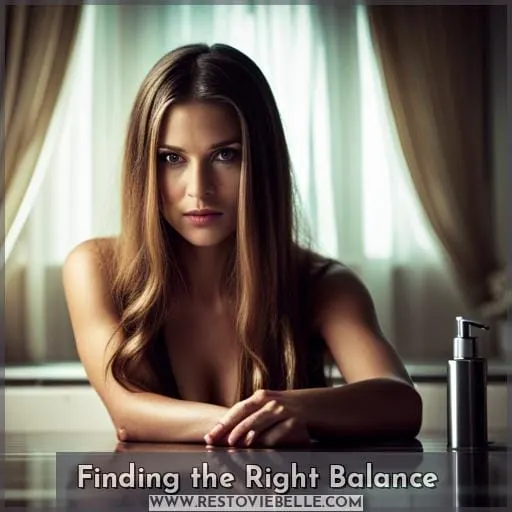This site is supported by our readers. We may earn a commission, at no cost to you, if you purchase through links.
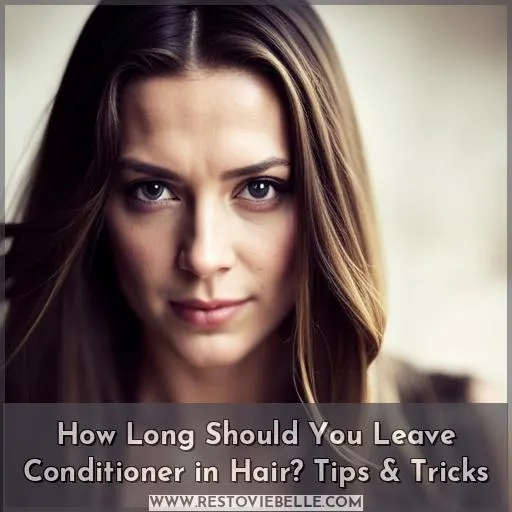 Take a moment to imagine the feeling of running your fingers through strands of soft, healthy-looking hair. That’s the goal for many — and with proper care, that dream can become a reality. The key is knowing how long to leave conditioner in your hair so you don’t overdo it or miss any spots.
Take a moment to imagine the feeling of running your fingers through strands of soft, healthy-looking hair. That’s the goal for many — and with proper care, that dream can become a reality. The key is knowing how long to leave conditioner in your hair so you don’t overdo it or miss any spots.
Depending on your hair type – oily, fine, or color-treated – there are specialized techniques and products available that will nourish your hair without weighing it down or making it greasy.
Not sure where to start? We have some tips and tricks from experts on optimal conditioning practices tailored for different types of tresses!
Table Of Contents
Key Takeaways
- Rinse-out conditioners should be left on for 1-5 minutes.
- Leave-in conditioners can be applied weekly or as needed.
- Deep conditioning treatments should be left on for 30+ minutes.
- Cleansing conditioners should be adjusted in frequency based on individual needs.
Optimal Conditioner Application
By understanding your hair type and using the right conditioner, you can achieve soft, shiny locks with balanced application. There are three main uses of conditioner: moisture replenishment, post-chemical treatment moisturizing, and heat damage recovery.
Rinse-out conditioners should be applied after shampooing a couple of times per week, while leave-in ones just once or more for those with curly or dry hair. Deep conditioning treatments left on for 30+ minutes repair very damaged or dry strands and should be used monthly.
Cleansing conditioners work well on fine or oily manes, but they all need to have their usage tailored to one’s individual needs in order not to overcondition it. Overconditioning can lead to greasiness and breakage due to protein overloads from these products’ ingredients like cationic surfactants, emollients, oils, and silicones.
The recommended leaving time is between 1 – 5 minutes depending on the type, so find what works best for your unique tresses!
Hair Types and Usage
No matter your hair type, conditioner is essential for achieving healthy and manageable hair. Fine or oily types need a rinse-out conditioner, while color-treated strands require special products like Vitamin B5 and oat protein to keep from fading.
For all textures, however, proper application of the right product is key to maintaining vital locks.
Fine Hair
For fine hair, it’s paramount to use a light conditioner that won’t weigh down your locks like an anchor. To maintain optimal pH balance and overall hair health, product selection is key. Pick one tailored for your specific type. Heat protection is also essential – leave-in conditioners are great for this! Best practice when applying: focus on the oldest part of the strands first and go from there.
When done correctly, you’ll enjoy benefits such as increased softness while protecting against dryness or breakage due to over-conditioning.
Oily Hair
Oily hair needs regular conditioning, but be careful not to overdo it as this can lead to greasiness. To reap the benefits of conditioner without overdoing it, opt for oil-based treatments like deep conditioning masks that use argan and jojoba oils.
When applying conditioner, focus on ends and avoid the scalp area where product can accumulate and weigh down your locks. Consider reverse washing – apply conditioner first, then shampoo – for added volume or cleansing conditioners which are great for fine oily hair types.
Color-Treated Hair
Treat your color-treated hair to the nourishing effects of Vitamin B5 and oat protein conditioners for luscious locks. Color-safe conditioners, like ARROJO’s Color Save Conditioner, lock in vibrancy and add shine, moisture, and smoothness.
Argan oil also provides a protective barrier against damage caused by coloring treatments.
For different hair types, there can be varying consequences from leaving in a conditioning treatment too long – find the right balance! Incorporate coordinating shampoo into your routine if needed.
Enjoy beautiful results without the risk of overconditioning: softer strands that won’t break or frizz out!
Conditioning Techniques
Using conditioner correctly is a key component in achieving healthy hair. To get the most out of your conditioning routine, try following recommended leave-in times and experimenting with reverse routines or deep-conditioning masks.
For an extra boost, opt for an aloe and rosemary conditioner to nourish all hair textures.
Recommended Leaving-in Time
Finding the right balance of conditioner usage and leaving-in time is critical – but how long should you actually leave it in? For daily conditioners, keep it to a minute or two. Color-safe products require longer lengths and ends; the reverse routine conditioning can help with heat damage recovery.
To avoid protein overload for porous hair, find the perfect balanced approach that works best for your specific hair type – recommended times vary depending on the product used.
Reverse Routine
Switch up your routine and try conditioning first, followed by shampoo for an extra boost of volume. Reverse conditioner application offers professional hair care benefits like heat damage recovery, moisture replenishment, and protein overload protection.
- Choose the right type of conditioner tailored to your needs
- Understand the order of use; apply before shampooing
- Follow instructions on timeframes for optimal results
- Don’t forget about ingredients like argan oils & oat proteins!
Deep-Conditioning Mask
Rejuvenate your tresses with a deep-conditioning mask for an instant transformation. The choice of conditioner depends on hair texture, but oil-based conditioners should be used sparingly. The key is to find a balance between conditioning frequency and type to avoid protein overload or over-conditioning of porous hair.
Applying a nourishing hair mask correctly can make all the difference, whether your hair is wet or dry.
Aloe and Rosemary Conditioner
Aloe and rosemary conditioner is a perfect choice for adding softness, shine, and moisture to your locks. It’s ideal for all hair textures, providing essential nutrients while protecting from heat damage.
A balanced approach with this conditioning mask will help you avoid protein overload that can lead to excessive breakage. Co-washing with aloe and rosemary conditioner provides great benefits like improved manageability while moisturizing the hair without leaving it greasy or heavy.
Effective Conditioning
Understanding the importance of regular conditioning and tailoring it to your hair type is essential for healthy hair. Unfortunately, many people make mistakes in application time – leaving conditioner on for too long or not long enough can have negative results.
To ensure optimal effectiveness, familiarize yourself with how long to leave conditioner in your hair.
Importance of Regular Conditioning
Regular conditioning is essential for keeping your tresses looking lively and healthy. It can hydrate, restore moisture balance, and prevent protein overload. Achieving the right balance requires tailored usage based on hair type and condition.
Rinse-out conditioner should be used a few times weekly; leave-in or deep conditioners more often for curly, dry hair. Cleansing conditioner, best suited to fine or oily strands, also needs regularity in use.
To achieve optimal results, it’s important to adjust the frequency of application according to the types of hair conditioners employed – from quick rinse-offs through overnight treatments – finding the ideal duration that works with your locks.
Tailored Conditioning for Hair Type
Tailoring your conditioner usage to your individual hair type will help you achieve the desired results. Coarse, curly, or dry hair may require more frequent use of leave-in and deep conditioning treatments for optimal moisture replenishment.
Fine or oily strands benefit from cleansing conditioners that cleanse as they nourish with Vitamin B5 and aloe vera extracts.
Avoid potential protein overload on porous hair by using gentle, moisturizing techniques like argan oil masks instead of heavy proteins such as oat proteins found in some post-chemical treatment products meant for heat damage recovery.
Don’t forget: underconditioned strands lead to breakage! Find the right balance between conditioning frequency, product type, and application time – this will ensure maximum shine, smoothness & volume without risking greasiness or overloading on protein!
Common Mistakes in Application Time
You may be making a common mistake in application time if you’re not tailoring your conditioning to your hair type. Proper usage of conditioner helps avoid greasiness and protein overload, ensuring optimal results for all types of hair.
Finding the right balance between applying conditioner and avoiding overconditioning is key. It’s about using just enough product to coat each strand without weighing down the shafts or causing damage due to prolonged exposure.
Knowing tips and tricks regarding the mechanism of action can help tailor usage accordingly. Use deep-conditioners for damaged hair and quick rinses for fine/oily tresses, etc.
Duration of Conditioning
As a general rule, it is recommended to leave conditioner in your hair for 3-5 minutes. Unfortunately, there are many misconceptions about the need for longer conditioning times, and varied practices exist depending on individual needs.
However, exceptions can be made with certain oil-based conditioners that require extended application periods.
Recommended Time Frame
Finding the right duration for your conditioner application is essential to maintain hair vitality. Tailored conditioning with an appropriate product, amount, and technique is necessary to achieve balanced results – too little or too much can lead to product buildup or dryness.
Consider different factors such as hair type and key ingredients when selecting the best option for you. Protein-based conditioners work well on porous hair, while argan oil helps damaged tresses recover from heat damage.
The recommended time frame varies but usually falls between three minutes up to a maximum of five minutes depending on the brand used.
With careful attention paid towards tailored conditioning techniques that target individual needs, you’ll be able to reach optimal levels of shine, smoothness, and buoyancy!
Misconceptions About Longer Conditioning
Many people believe that leaving conditioner in for extended periods will yield better results; however, this is a misconception. Over-conditioning can lead to scalp irritation or excess oiliness, and protein overload on porous hair can result in more damage than benefit.
Rather than relying solely on time, consider the type of conditioner you use – one with vitamin-rich ingredients may be optimal when co-washing or using oil-based products for damaged locks. Ultimately, personal preferences vary, but sticking within 3 to 5 minutes helps prevent over-conditioning while still achieving desired effects.
Varied Practices and Exceptions
When it comes to conditioning your hair, there’s no one-size-fits-all approach. Practitioners’ techniques vary from quick applications to overnight treatments.
Depending on the conditioner type and hair type considerations, a balanced approach can help achieve vitality in your locks. Popular types include rinse-out and leave-in deep conditioning treatments. These treatments not only replenish moisture but also contain key ingredients like cationic surfactants and silicones for extra shine.
Healthy habits, such as using cleansing conditioners or heat damage recovery products, are important for achieving overall healthy hair results.
Finding the Right Balance
As an experienced hair care specialist, you know that proper conditioning is essential to keep your hair healthy. However, over-conditioning can lead to greasiness and breakage – especially with porous or protein-based conditioners.
To get the best results for your specific hair type, it’s important to adjust usage accordingly and find the right balance between conditioner type and application frequency.
Potential Risks of Over-Conditioning
You risk damaging your hair and causing breakage if you over-condition, with a potential of up to 70% of proteins being stripped. Understand the conditioner type best for your hair type and adjust application frequency accordingly.
Oil-based conditioners should be used sparingly as they can lead to protein overload while maintaining moisture is key in avoiding heat damage or styling fatigue. Keep an eye out for signs like greasiness, loss of volume, excessive shine – all indicators that you may have overdone it! Selecting products tailored specifically to your hair health needs helps keep locks healthy without risking unnecessary damage from too much conditioning time.
Protein-Based Conditioners and Porous Hair
Energize your locks with protein-based conditioners to restore strength and elasticity to porous hair. Silicone-based products help lock in moisture while protecting from further damage caused by dyeing or environmental factors.
But be careful not to go overboard with these proteins – too much can lead to hair loss through an overload of the strands’ natural structure.
Tailor your approach according to your unique hair type and conditioning frequency. Whether it’s wavy, curly, fine, or oily, experiment between various textures until you find a balance that works best for you! Give yourself smoothness and shine without risking any unnecessary breakage due to the harsh effects of overconditioning.
Adjusting Usage Based on Hair Type
It’s essential to adjust your conditioner use based on your hair type for maximum benefit. Fine and oily hair needs rinse-out or cleansing conditioners applied a few times weekly, while coarse, curly, dry locks require more frequent conditioning with leave-in or deep treatments.
Key ingredients like cationic surfactants and emollients help replenish moisture as well as protect from humidity and heat damage.
Frequently Asked Questions (FAQs)
What are the best conditioner ingredients for colored hair?
Nourish your colored hair with conditioners containing vitamin B5 and oat protein for optimal results. Enjoy soft, smooth locks that are protected from fading and damage while enhancing vibrancy, shine, and moisture.
Does conditioner work better on wet or dry hair?
Applying conditioner to wet hair is like putting icing on a cake – it helps lock in moisture and nourishment for healthy, shiny locks. Make sure to massage the product into your strands for maximum absorption and use the right type of conditioner tailored to your needs; leave-ins work best if you have fine or oily hair, while deep treatments are ideal for coarse textures.
How can I prevent my hair from becoming too oily when using conditioner?
To prevent your hair from becoming too oily, use conditioner tailored to your hair type. Avoid applying it near the roots and focus on the oldest, driest parts of your hair. Follow instructions carefully; using too much or leaving it in for longer than recommended can make you greasy! Experiment with different techniques to find what works best for you.
Can I use conditioner as a shampoo?
You can get away with using conditioner as shampoo, but it’s not ideal. It won’t cleanse your scalp and hair as effectively, and you could end up with a buildup of product. Pick the right kind for your hair type to maximize effectiveness while avoiding greasiness or dryness.
How often should I use a deep conditioning mask?
Use a deep conditioning mask once a month for healthy hair. It adds shine, moisture, and smoothness. Plus, vitamin-rich formulas lock in color vibrancy up to five times longer than regular conditioners! Give it time to work its magic – leave it on for 30+ minutes – for optimal results.
Conclusion
To sum it up, the key to achieving healthy hair lies in understanding your hair type and finding the right balance between conditioner type and application frequency. As the old saying goes, you can have too much of a good thing – the same applies to conditioner.
Too much can lead to greasiness, loss of volume, and breakage, while too little can result in dry, brittle strands, tangling, and dullness.
To get the most out of your conditioner, opt for a rinse-out or cleansing conditioner for fine or oily hair, and a leave-in or deep conditioner for coarse, curly, or dry hair. Lastly, always follow the recommended leaving-in time – usually around 2-3 minutes – to avoid wasting the conditioner’s full potential.
With these tips, you’ll be well on your way to having manageable, vibrant, and luscious locks.
